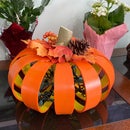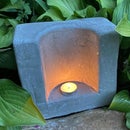Introduction: How to Make a Ulu Knife From a Old Saw Blade Plus a Bonus Cutting Board
Instead of discarding the old 12 inch saw blade off my miter saw I decided to recycle it into my version of a ulu knife using the tools I had available. It was a fun project and I tried to include as many photos as I could. As a bonus I am also including how I made a ulu cutting board with a knife holder. And as I am not a professional knife maker I didn’t do some steps such as heat treating the blade which I’m sure would help to keep the knife sharper longer. Thanks for looking and be sure to post your version of a ulu knife if you decide to make one. Find more photos of finished knife and cutting board in last section.
Supplies
Safety equipment:
- eye protection
- face shield
- heavy gloves
- clamps to secure work
Supplies for knife
- saw blade
- cutting wheels
- grinding wheels
- sandpaper
- buffing wheel & compound
- 5 minute epoxy
- masking tape
- drill bits
- finish for knife handle
Supplies for cutting board
- wood strips
- gorilla glue
- food safe oil finish
- double sided tape
- scrape 9" x 9" mounting board
- two stainless steel screws
Machines I used
- right angle grinder
- sanders
- buffing wheel
- drill
- dremel
- clamps
- lathe
Step 1: Designing the Ulu Knife
- I started out by laying out a 5 1/4 inch by 4 1/8 inch section.
- I used a paper plate for blade curve.
- I used a 5 gallon bucket for handle top curve
- I used a cool whip container for side of blade curve
- Follow steps on photos for remainder of dimensions
Step 2: Cutting the Ulu Knife Out of the Saw Blade
- Start by laying your ulu paper template out on the saw blade and mark out with a marker.
- "IMPORTANT" be sure to secure metal blade before working on it and always wear safety equipment when working or cutting on the blade.
- I used a right angle grinder with a 4 1/2 inch cutting wheel to do most of the cutting.
- I used a drill bit in the inside corners of the blade.
- To finish the cuts I couldn't get with the 4 1/2 inch cutting wheel I used a 1 1/2 inch cutting wheel on a dremel.
- When cutting out the blade side of the knife I took my time so the metal wouldn't get to hot and even sprayed it with a water bottle to keep it cool. I was trying not to weaken the metal on the blade cutting side.
- I finished off by using a metal file and grinding stones to clean up lines were I could.
Step 3: Sanding and Polishing the Ulu Knife
- After getting the outer edges of the knife cleaned up I used a sanding disc on the grinder to remove the print on the blade.
- Next I used a pneumatic right angle sander to sand the blade starting with a heavy grit and finishing with a 1200 grit sand paper.
- Next I polished the blade using a polishing compound on a buffing wheel.
- Next I started grinding a edge on the blade (I should have done this step before sanding blade)
- I ended up having to resand and polish blade again. And this wasn't the last time.
Step 4: Placing Wood Scales on Ulu Knife
- For the knife scales I used two pieces of padauk wood that was about 3/8 inch thick and two 7mm tubes for pins.
- Next I drilled two hole in the knife to accept pin tubes
- Next I marked out the wood scales to fit the shape of the knife handle.
- Next I cut and sanded the wood scales just outside the lines I marked. You will finish shaping after they are glued on the handle.
- Next glue and clamp the wood scale on one side of the knife with 5 minute epoxy and let harden.
- Next drill pin hole through the wood scale you attached.
- Before attaching other scale be sure to sand any epoxy that may have gotten on the other side of the handle.
- Next glue and clamp remaining scale on handle.
- Next cut and glue tube pins in handle.
- And before shaping wood scales on handle be sure to tape off metal parts of knife with masking tape.
Step 5: Shaping and Sanding Ulu Handle Before Applying a Finish
- I started shaping the wood handle by using a pneumatic sander for the rough shaping.
- The first step I did was to take the wood down to the metal on the outer edges of the handle.
- Next I rough shaped the profile of the handle to the shape I wanted.
- I finishing up by hand sanding starting with 180p grit sand paper and stopped at 400p grit sandpaper.
- Before applying a finish be sure to remove any sanding dust.
- Next apply a finish of your choice. Photo shows how I clamped knife to apply finish. I went with a ca finish which is a durable finish many pen turners on there higher end writing pens . It's a finish where you apply many coats of thin ca glue (a type of super glue) and then sand smooth and polish with a buffer.
Step 6: Cutting and Gluing Wood Strips for Ulu Cutting Board
- I cut enough pieces of maple and african mahogany strips to make a cutting board nine inches wide when all glued together. All the pieces I used were almost 1 1/2 inch thick.
- Next I sanded matting sides flat before gluing.
- After removing sanding dust I glued and clamped all the pieces together using gorilla glue.
- After the glue had dried I removed the excess glue and flat sanded the board with a belt sander.
- I finished sanding with a orbital and sheet sander.
Step 7: Placing Cutting Board on Lathe and Cutting Concave in It
- I didn't want to attach a lathe mounting chuck directly to the cutting board so I cut a scrap 9" x 9" board to place the chuck on and then used double sided tape to connect the cutting board to it. I also wrapped two inch masking tape around the outside edge to help secure it.
- After attaching cutting board to the lathe I cut a concave in the cutting board that was about 6 3/4 inches across and about 5/8 inch deep.
- Next I hand sanded the cutting board and then removed the sanding dust.
- Final step is to apply a food safe oil to the cutting board. I used a walnut oil on this one.
Step 8: Making Side Knife Holder for Ulu Knife
- To make the knife holder I used two pieces of 1/8 inch thick padauk wood.
- I taped off one of the pieces of wood so I could see my cut lines better after laying the knife out on it.
- After cutting it out I glued the cut piece of padauk with the full piece. ( just follow photos )
- Next I cut it down to 8 inches long and sanded a 45 degrees on each end.
- Next I drilled a hole on each end for mounting screws. I wanted it removable incase it had to be replaced or cleaned.
- Next I put a finish on it before mounting.
- Last step was to mount the holder to the cutting board using two stainless steel screws.
Step 9: Finished Photos to Inspire You to Make a Ulu Knife
Thanks for looking and be sure to post pictures of your ulu knife if you decide to make one. And if you get a chance check out my Etsy store at resinandwoodworld.etsy.com or you can find me on Instagram at resinandwoodworld.

Grand Prize in the
Trash to Treasure Contest













